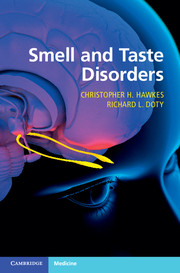Book contents
- Smell and Taste Disorders
- Smell and Taste Disorders
- Copyright page
- Contents
- Preface
- Acknowledgments
- Chapter 1 Anatomy and Physiology of Olfaction
- Chapter 2 Anatomy and Physiology of Gustation
- Chapter 3 Measurement of Olfaction
- Chapter 4 Measurement of Gustation
- Chapter 5 Non-neurodegenerative Disorders of Olfaction
- Chapter 6 Non-neurodegenerative Disorders of Gustation
- Chapter 7 Neurodegenerative Chemosensory Disorders
- Chapter 8 Assessment, Treatment, and Medicolegal Aspects of Chemosensory Disorders
- Index
- References
Chapter 3 - Measurement of Olfaction
Published online by Cambridge University Press: 17 January 2018
- Smell and Taste Disorders
- Smell and Taste Disorders
- Copyright page
- Contents
- Preface
- Acknowledgments
- Chapter 1 Anatomy and Physiology of Olfaction
- Chapter 2 Anatomy and Physiology of Gustation
- Chapter 3 Measurement of Olfaction
- Chapter 4 Measurement of Gustation
- Chapter 5 Non-neurodegenerative Disorders of Olfaction
- Chapter 6 Non-neurodegenerative Disorders of Gustation
- Chapter 7 Neurodegenerative Chemosensory Disorders
- Chapter 8 Assessment, Treatment, and Medicolegal Aspects of Chemosensory Disorders
- Index
- References
Summary

- Type
- Chapter
- Information
- Smell and Taste Disorders , pp. 80 - 137Publisher: Cambridge University PressPrint publication year: 2018
References
- 1
- Cited by

